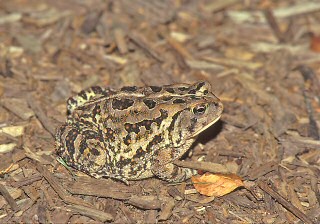|
Trail Guides
|
Dix Wildlife Management Area
|
7
 
|
Back Neck Road, Fairton, NJ
Phone: (609) 984-0547
www.njfishandwildlife.org
NJ Department of Environmental Protection
Turn Right out of the Cohansey Restoration Site onto CR 601/Back Neck Rd. Continue down Back Neck Rd. and you will
pass a sign for the Dix Wildlife Management Area. One mile after you pass the sign, the road becomes a dirt road and continues into the
WMA for 2.5 miles.
To access a second entrance to Dix Wildlife Management Area, turn around and drive back down Back Neck Rd. Turn Right onto School-house Rd., heading South. At the next stop sign, turn right onto the dirt road. Drive to the end and park to walk out on the old dike or turn Left onto the next dirt road to explore further. Map
Open daily from dawn to dusk. No parking lot, but you can pull off and park on the side of the road.
 |
| Woodhouse's Toad | Kevin Karlson |
| |
| | Dix WMA is a little-known jewel surrounded by vast marshlands and bounded by the Delaware Bay to the west. The fields, small woodlots, and forested wetlands provide a mosaic of critical resting, nesting and feeding habitat attractive to a variety of wildlife. Its somewhat remote location keeps it off the beaten path, which is appealing for many wildlife watchers. Take a walk on the old dike in any season to see Bald Eagle. In winter, at least three nests are visible across the mudflats created when the dike breached several decades ago. River otter frequent the creeks and use the dike as a travelway. Look for their scat (full of fish scales) and slides (they love to slide down the banks on their bellies). This is a great place to see waterfowl, herons, egrets and wading birds. The forests provide ideal nesting habitat for a number of raptors and virtually every resident woodland passerine found in this part of New Jersey nests here. The hedgerows between the fields are favored by sparrows,
warblers and songbirds. The roads are generally unpaved but are easily driven without a four-wheel drive vehicle except after heavy rains or following significant snow fall.
Snow Geese winter here by the thousands and Northern Pintail, American Black Duck and Bufflehead are almost guaranteed. Northern Harrier patrol the marshes. Eagles are often seen overhead or perched in the snags along the edge of the marsh. Great Horned Owl mate in late December and are on their nests in January. Bald Eagle do the same in February.
The Snow Geese depart and migrating birds arrive, some to nest and others to stop to rest after crossing the Delaware Bay before they fly farther north. Muskrat, frog, turtle, snake and the birds of the marshes bring the wetlands to life. Many mammals — deer, raccoon, skunk, opossum, squirrel and rabbit may be seen
foraging in the forest, especially around dusk.
This is insect time in the forests, fields and marshlands, so long sleeves and insect repellent are highly recommended. Look for Indigo Bunting, Blue Grosbeak and American Goldfinch along the field and meadow edges and Scarlet Tanager in the forest. This is a great time to look for butterflies and to try your hand at wildflower identification.
The southern migration of raptors and passerines is underway; keep an eye overhead to witness the steady stream. By late fall the Snow Geese have returned. Look for Wild Turkey in the fields and at the forest edge.
|
|
|